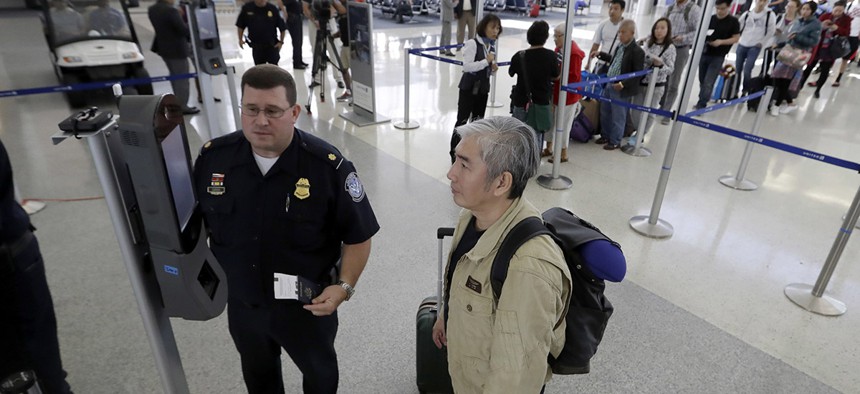CBP Rolls Out Facial Recognition at Silicon Valley Airport

U.S. Customs and Border Protection supervisor Erik Gordon, left, helps a passenger navigate one of the new facial recognition kiosks at a United Airlines gate before boarding a flight to Tokyo. David J. Phillip/AP
International travel at the Mineta San José International Airport has doubled in recent years.
Things move fast in Silicon Valley. Companies can boom or bust overnight, innovative technologies constantly disrupt markets, and technologists are now bringing the same speed to international terminals in the region’s biggest airport.
Customs and Border Protection last week announced an initiative with Mineta San José International Airport to roll out facial recognition technology for all international travelers entering and leaving the country. The airport, which sits within 20 miles of Facebook and Google headquarters, becomes the first West Coast hub to commit to full biometric entry and exit.
The facility began using biometric facial recognition to process all arriving international travelers on June 25 and this fall it will implement similar technology for at seven gates to scan passengers before they leave the country.
“As one of the nation’s main regions of innovation, Silicon Valley is at the forefront of transforming the travel experience through biometrics,” said CBP Commissioner Kevin McAleenan in a statement. “CBP is excited to partner with SJC, which serves as another example of what we can achieve by advancing the entry/exit mandate through public-private collaboration, adding benefits for travelers and stakeholders across the air travel ecosystem.”
With Silicon Valley playing an increasingly significant role on the world stage, international travel to the region has skyrocketed. In recent years, traffic at the San José hub more than doubled from some 200,000 international arrivals in 2015 to nearly 440,000 in 2017.
Facial recognition technology not only increases airport security but also allows CBP to process more people in the same amount of time without increasing its staff, according to the agency.
While a number of airports have already adopted facial recognition for departing passengers, SJC is one of the first to use the technology for incoming travelers.
Upon arrival, passengers on international flights typically have to stop at a kiosk to scan their passports, have their photos taken and answer customs inspection questions before getting in line to see a security officer. But the new system eliminates the kiosk and cuts the time it takes to process inbound foreign nationals by more than 85 percent, John Wagner, CBP deputy assistant commissioner and the senior executive overseeing the entry/exit program, told Nextgov in June.
The technology’s rollout comes as the airport invests $8.2 million in expanding and renovating its international arrivals facility.
“The use of biometrics technology will help cut down wait times and enhance the overall experience for our international travelers, especially as we continue to see unprecedented growth at SJC,” said San José Mayor Sam Liccardo in a statement. “Today’s announcement offers another great example that San José continues to leverage technology to better serve our community.”



